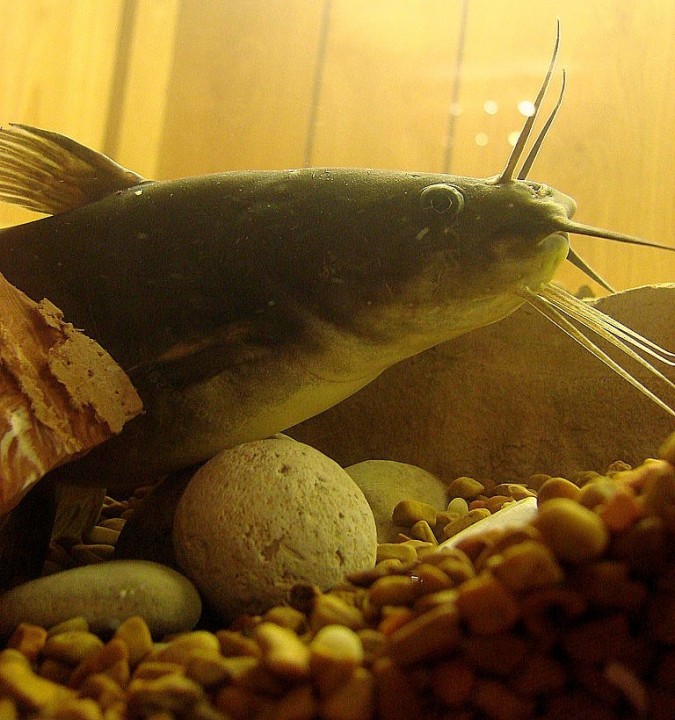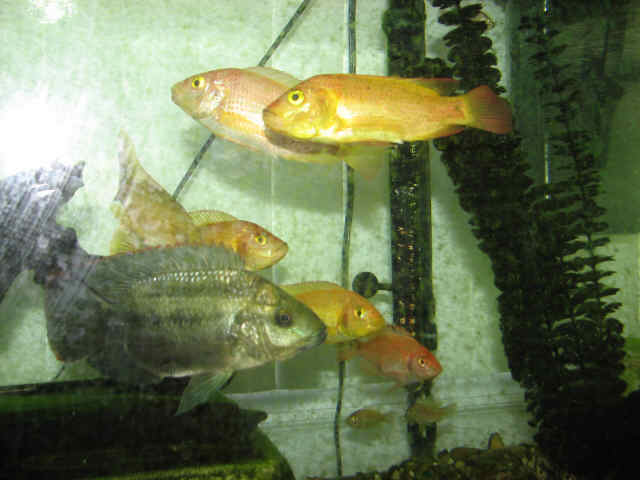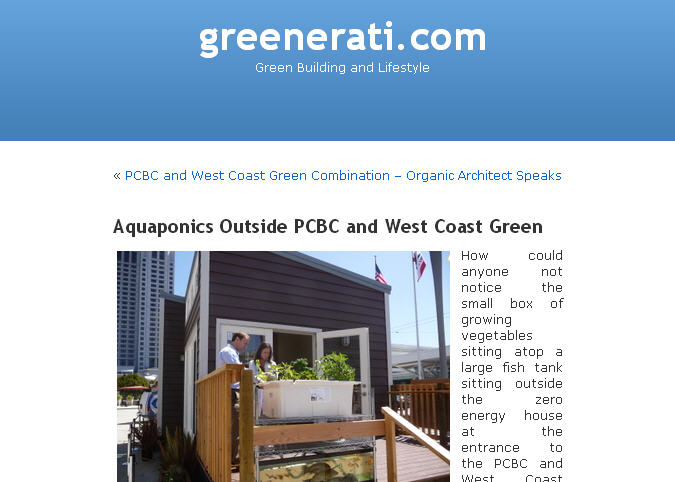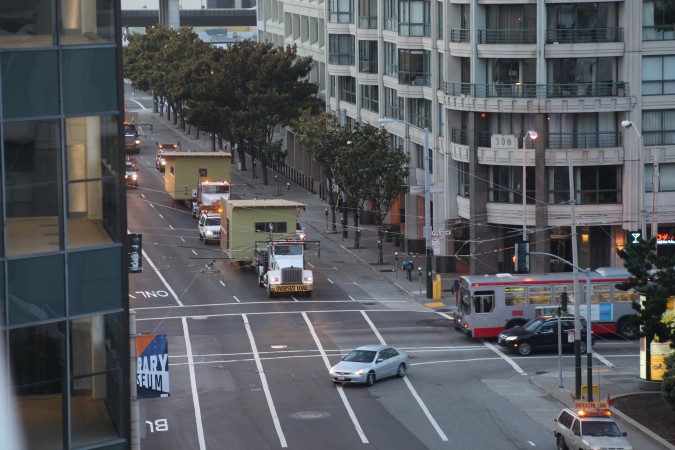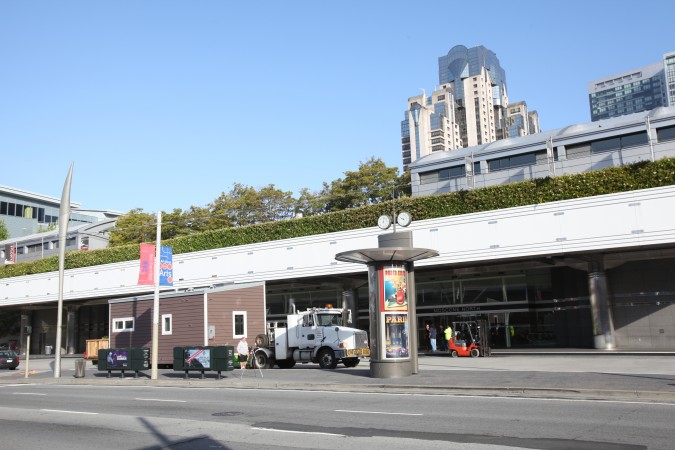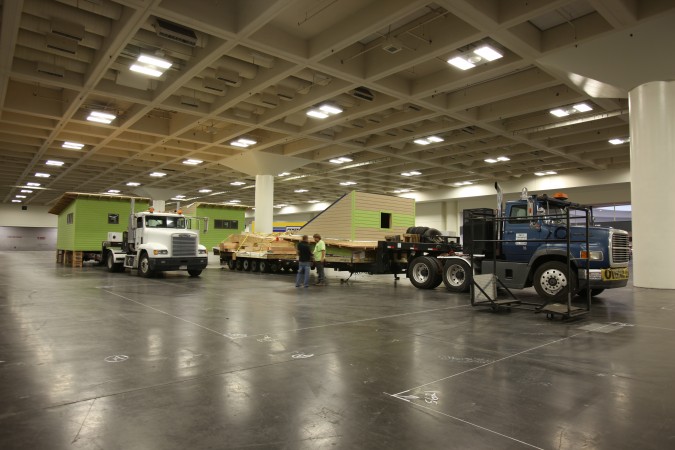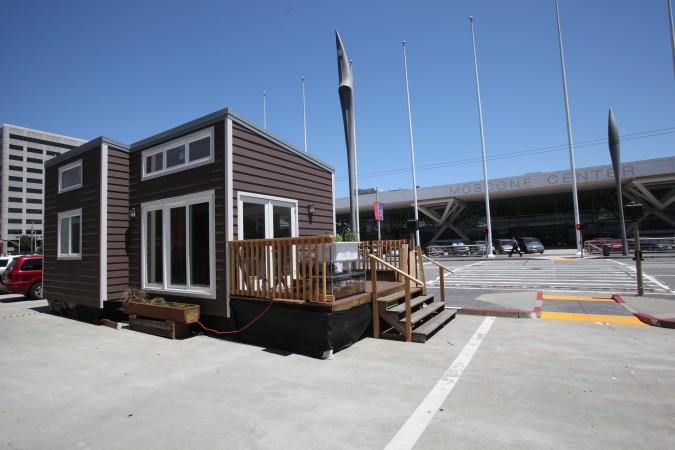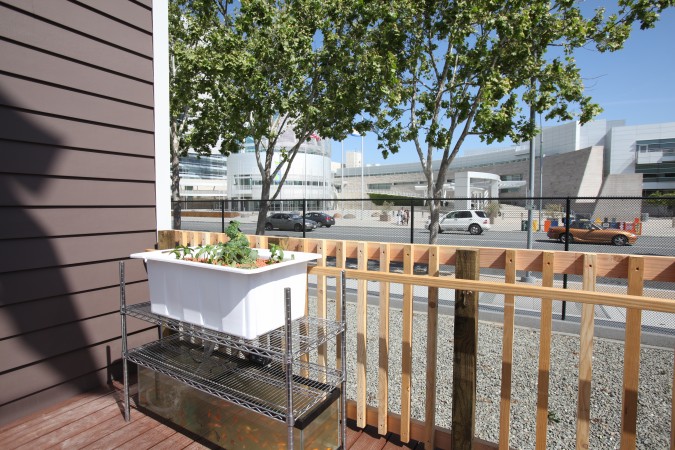Archive for the ‘aquaponics’ Category
Raising catfish in a barrel
Today I released 25 two inch long Brown Bullhead Catfish into my aquaponics system fish tank.
I bought these fish from a licensed aquaculture dealer I identified on the California Department of Fish and Game department website. The dealer recommended these catfish over other types of catfish because he said they grow better in aquaponics systems and are very hardy. Since I’ve lost all my full size catfish I bought at the supermarket, I needed to try something different.
While researching raising catfish, I discovered this 1973 article by Philip and Joyce Mahan about how to raise catfish in oil barrels. I would be scared to use an oil barrel since I’d be worried about contamination, but the article does impart useful information, including how to raise worms to use at catfish food.
Cross your fingers that my 25 new ‘roommates’ have a long and happy life!
Tilapia in San Francisco?
I am finding it difficult to learn for certain if I may raise Tilapia fish in my aquaponics system in my backyard in San Francisco, California.
The California Department of Fish and Game website is not helpful, because it doesn’t appear to address aquaponics, where the fish are kept in an enclosed aquarium, not in a pond, wetland, river, lake or ocean.
I have found websites that suggest I may raise Tilapia anywhere in California provided I select the correct type of Tilapia. One such website, Tilapia farming at home is clear on this subject, but even so, I want to be sure I comply with the law.
Governments can hand out severe punishments for raising Tilapia where not allowed. I watched a DVD about aquaponics in Australia, and the fine for having a dead or alive Tilapia fish in the wrong part of Australia is over $100,000 Australian dollars!
Greenerati.com writes about my aquaponics system at PCBC
Blogger, writer and consultant Keith Rockmael wrote the post Aquaponics Outside PCBC and West Coast Green about my aquaponics system that’s been on display this week at PCBC in front of Moscone Center in San Francisco, California USA.
Here’s a screen capture of just the first part of the post… please be sure to click on this link to send him some traffic.
The house in the background is by New Avenue, Inc.
Moscone North is to the immediate left, as this house is sitting in the driveway in front.
New Avenue personnel staffing the New Avenue eco house told me that representatives from three other trade shows asked about getting an aquaponics display for their shows. If these trade show representatives are reading this post, I am interested in helping out, even though I am not in the aquaponics business.
I’m a software entrepreneur that’s simply fascinated by aquaponics.
Video of New Avenue, Inc. houses being delivered to Moscone Center for PCBC June 22-24, 2011
In my blog post from yesterday, June 17, 2011, entitled New Avenue brings two of its homes to Moscone Center for the Pacific Coast Builders Conference June 22-24, 2011 I wrote about the spectacular delivery of two houses to the Moscone Center in San Francisco, California USA.
I used my Canon 5D Mark II camera to shoot high definition video of the delivery process. HD video takes time to process and upload, so the clip wasn’t ready by the time I published yesterday’s story.
As promised, here is the clip I assembled of the houses arriving from San Jose, California.
The first part of the video shows 3 large semi trucks driving up 3rd Street and descending down the loading dock adjacent to Moscone South. Moscone Center is composed of 3 large halls – South, North and West, built in that order over years. I follow these trucks into Moscone South, which was the incorrect hall, as workers told me the South hall is undergoing renovations and thus shows aren’t currently being held in it. Even though this was a mistake on the truck driver’s part, I include the video because most readers of this article will have never seen the South hall totally empty, like it is in this clip. The South hall is the most impressive of the three halls because there are no support columns in the middle of the room. It’s nearly a square block of unobstructed space, and it’s stunning to behold devoid of all the commotion present when it’s occupied.
Off video the trucks then snaked through the tunnel underneath Howard Street into Moscone North, which is where the PCBC conference will take place June 22-24, 2011.
Before we see the houses inside the North hall, the video switches to the driveway for the North hall, on Howard Street. A 4th semi truck brings a second house, complete with deck and my aquaponics system, and parks it parallel to Howard Street and the entrance to the hall.
The video concludes with a clip showing one of the semi trucks inside the North hall driving out from under one of the parts of the first house after that house was temporarily set on blocks. Although it’s not shown in this video, the house pieces were later lowered from their blocks onto their ‘foundations’ and the house pieces were put together to form one elegant ~750 square foot home that will be a featured attraction at PCBC next week.
New Avenue brings two of its homes to Moscone Center for the Pacific Coast Builders Conference June 22-24, 2011
My friend Kevin Casey is on a roll with his New Avenue, Inc. startup.
Today he was literally on a roll, or, rather, two of his company’s products were rolling up Route 101 from San Jose, California to San Francisco, California, about 50 miles.
New Avenue designs, finances, builds and installs quality ADUs, which stands for Accessory Dwelling Units. ADUs are commonly known in the US as inlaw units or granny units. An ADU is a smaller house destined to be a second home on a single family residential lot. It’s public policy and official law in California that cities allow ADUs.
The two New Avenue products rolling up 101 are houses ready for decades of full time living. These are not cheap mobile homes destined for the scrap heap in 15 or 20 years. These are quality homes built with high quality materials and appliances. New Avenue homes are luxurious enough that they make sense in even the backyards of wealthy Californians.
I’ve a big fan of what Casey is doing, and I’ve written here about New Avenue four times before. I have even toyed with the idea of ‘competing’ with Casey by making ADUs from recycled ocean shipping containers. I’ve shelved those plans to focus my efforts on gOffice and its companion blog. But the concept of living in a smartly designed smaller home that consumes fewer resources is profoundly appealing to me, which is why I follow Casey’s progress with such fascination.
As I wrote about here last month, Kevin Casey invited me to build an aquaponics system for one of his homes. That home has been on public display in front of the new City Hall in San Jose, CA for the last six weeks or so. San Jose was gracious enough to allow Casey to reposition the house for a week so it could be shown publically at the Pacific Coast Builders Conference (PCBC), happening at the Moscone [Convention] Center in San Francisco June 22-24, 2011, next week.
San Jose paid Casey to build the house as part of a green technology exhibit called the San Jose Green Vision Clean Energy Showcase funded by the United States Department of Energy with Recovery Act money. It was via the San Jose exhbit that New Avenue came to the attention of the PCBC conference, which paid Casey to design and build the larger ~750 square foot house you see disassembled on the three semi trucks in the picture at the top of this article. This green home which is also green in color, will be a centerpiece of the PCBC convention, and it is literally in the center of Moscone North. The houses were delivered at 5:50 this morning, just as the sun was rising, so that’s why the picture is dark… note the reflection of the headlights on the pavement. I was extremely lucky that the Moscone parking garage opened 15 minutes early at 5:45am. If it hadn’t, I wouldn’t have been six stories up with a windowless view of 3rd street to take the picture above. Thank you to the garage staff!
The San Jose exhibit house, painted brown, is now in the driveway in front of Moscone North, at street level. This means thousands of cars will pass this house for the next week or so, and thousands of people will walk past it. As far as I know, no admission will be charged for members of the public to tour this house, so you don’t need to be a paid attendee of the PCBC conference to pay a visit.
The aquaponics system I built for Casey is on the front deck, just as it is when the house in in San Jose. The plants in the grow bed survived the windy truck ride North without cover, to my amazement. I didn’t want to risk the fish splashing out of the aquarium onto the roadway, so I removed them yesterday and brought them home with me in my car. I cleaned up the tank, filled it with declorinated fresh water and reintroduced the fish to their home this afternoon, once the New Avenue house was safely parked in San Francisco.
I will be on hand during the PCBC conference to explain aquaponics to visitors. I already told a dozen people about aquaponics today — mostly Moscone Center staff, including Lorenzo, a journeyman painter who engaged me in 20 minutes of conversation about small home living and gardening. He was extremely enthusiastic about aquaponics and the New Avenue house… he really wanted the house for his vacation property where he goes hunting and fishing.
I shot video of the house moves, and it’s being encoded for upload as I write this post. I will add a companion post tomorrow to show that video. These houses are so large they needed multiple escort vehicles to get to San Francisco safely. It was quite a spectacle watching the 750 square foot home be delivered by three trucks into the convention center. Be sure to have a look at that video on June 18, 2011.
I built my first aquaponics system – you’ll never guess where it is
I’ve written about my friend Kevin Casey a few times before (January 7, 2011, January 9, 2011 and January 11, 2011). I met him in 2007 when he was one of the student organizers for the University of California Berkeley Business Plan Competition. I was a judge and financial sponsor for that competition, so we had plenty of opportunities to talk. We became friends on Facebook, and when he started posting status updates about his startup New Avenue, Inc., I got back in touch with him.
Kevin staged the ribbon cutting for his first house on January 8th, 2011. Soon after, the city of San Jose, California contacted Kevin and asked that he construct a custom house for a 9 month exhibit of green technologies called the San Jose Green Vision Clean Energy Showcase. This exhibit opened this month, in May, 2011. The location is directly across the street from the sparkling City Hall of San Jose.
Here’s the PDF brochure that San Jose is distributing about its Clean Energy Showcase.
Ever since I contacted Kevin in late 2010, I have been talking his ear off about my ideas for shipping container based green housing. One of the parts to my grand plans is to make it practical for residents to grow food at home. The most exciting and productive way to grow food in limited space with limited water is to raise fish and vegetables in symbiotic harmony. This technique is widely known by the word ‘aquaponics.’
Kevin approached me and asked if I’d like to set up a small demonstration aquaponics system on the front porch of his New Avenue demo green home. I jumped at the chance, as this gives me a great excuse to learn more about this and help a friend at the same time. Aquaponics is really popular in Australia, which is in the midst of an 11 year draught. Aquaponics systems use 1/10th the water required to grow vegetables in dirt. Since the world is ‘running out’ of fresh water, it makes sense to learn more about a system that makes such efficient use of water.
I put together a system with off the shelf parts I selected and modified personally. The result doesn’t look bad, but doesn’t look like a commercial polished product either. I am happy with the result for my first system. I used a wire shelf rack from Costco as the frame. I was concerned that infants could drown in a system that didn’t fully cover the water tank, so by setting the height of the first shelf to just over the height of the water tank, I eliminated that risk. You can see this safety feature in the picture above.
The water aerator and the timer are located in an exterior grade water resistant steel junction box fastened to the rear shelf. From there, the system is connected to a GFCI outdoor outlet on the rear of the house. While you can’t see it in the picture because I hadn’t installed it yet, the fish are fed automatically each day via a timed automatic fish feeder.
The vegetable bed is flooded with a foot of water from the fish tank 24 times a day. The flood/drain cycle takes about 18 minutes, and starts on the top of each hour. The pump consumes just 18 watts during a 15 minute per hour fill cycle. The extra 3 minutes is the time it takes for the growing bed to drain back into the fish tank.
The vegetable roots cleanse the water. Since the vegetables get all the water they can absorb, they grow faster than in dirt, up to 600% faster. The fish also grow faster than normal because they get so much clean and well aerated water. It’s a true win/win scenario. The main inputs are fish food and water to replace what is lost to transpiration and evaporation. On occasion, there are tiny inputs of a teaspoon or so of fluid to adjust the pH to keep everything happy. I understand that this is needed primarily during the first 6 weeks of operation, before the healthy bacteria have established themselves in the clay beads that the plants grow in.
I am no expert, but I’m learning a lot, and I appreciate the opportunity to learn on such a public stage. I’ve already met two people that have seen my system and want one of their own!
To learn more, read Backyard Aquaponics Magazine.
Special thanks to Sylvia Berstein, Founder and CEO of The Aquaponic Source, who helped me set up my first system and sold me some of the key parts. Her store is located in Boulder, Colorado, USA.
